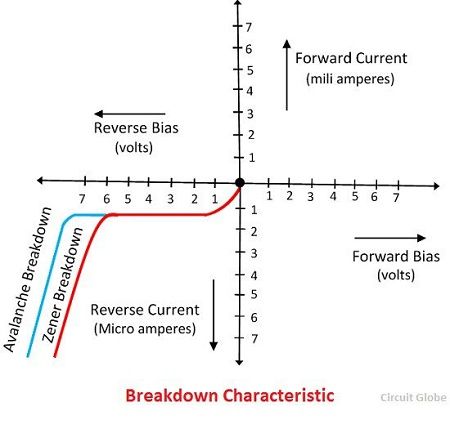One of the major difference between the Avalanche and the Zener breakdown is that the Avalanche breakdown occurs because of the collision of the electrons, whereas the Zener breakdown occurs because of the high electric field. The other differences between them are explained below in the comparison chart.
The charge carrier of the PN-junction diode absorbs heat from the environment at normal room temperature. When the reverse biased applied across the junction, the kinetic energy of the electrons increases and they starts moving at high velocity. While moving, they collide with the other atoms and creates the number of free electrons which causes the reverse saturation current. Because of this saturation current, the avalanche breakdown mechanism occurs in the diode.
The Zener breakdown takes place in heavily doped diodes. When the high electric field applied across the diode, the electrons start moving across the junction. Thus develop the small reversed bias current. When the jumping of electrons increases beyond the rated capacity of the diode, then avalanche breakdown occurs which breaks the junction. Thus, as long as the current in the diode is limited the Zener diode will not destroy the junction. But avalanche breakdown destroys the junction.
Content: Avalanche Vs Zener Breakdown
Comparison Chart
| Basis For Comparison | Avalanche Breakdown | Zener Breakdown |
|---|---|---|
| Definition | The avalanche breakdown is a phenomena of increasing the free electrons or electric current in semiconductor and insulating material by applying the higher voltage. | The process in which the electrons are moving across the barrier from the valence band of the p-type material to the conduction band of the lightly filled n-material is known as the Zener breakdown. |
| Depletion Region | Thick | Thin |
| Junction | Destroy | Not Destroy |
| Electric Field | Weak | Strong |
| Produces | Pairs of electron and hole. | Electrons. |
| Doping | Low | Heavy |
| Reverse potential | High | Low |
| Temperature Coefficient | Positive | Negative |
| Ionization | Because of collision | Because of Electric Field |
| Breakdown Voltage | Directly proportional to temperature. | Inversely proportional to temperature. |
| After Breakdown | Voltage vary. | Voltage remains constant |
Breakdown Characteristic Graph
The graphical representation of the Avalanche and Zener breakdown is shown in the figure below.
Definition of Avalanche Breakdown
The avalanche breakdown is the breakdown mechanism of the PN – junction diodes which have thinner region. In this breakdown, when the electric field is applied across the diode, the velocity of the charge carrier increases. This charge carrier collides with the other atoms and creates the pairs of hole and electrons.
The free charge carrier further collides with other atoms and creates more pairs of electron and hole. These free electrons start moving across the junction and develop the reverse bias current. The reverse bias current completely destroys the junction. And once the junction breakdown occurs, it cannot regain its original position.
Definition of Zener Breakdown
The junction breakdown mechanism which occurs in the heavily doped thin region is called Zener breakdown. In this mechanism when the high electric field is applied across the junction, the charge carrier starts jumping across the junction. These electrons constitute the heavy current in the reversed direction. In Zener breakdown, the temporary breakdown of junction occurs. The junction regains its original position when the reverse voltage removes.
Key Differences Between Avalanche & Zener Breakdown
- The breakdown which occurs because of the collision of the electrons inside the PN-junction is called avalanche breakdown, whereas the Zener breakdown occurs when the heavy electric field is applied across the PN- junction.
- The avalanche breakdown occurs in the thick region, whereas the Zener breakdown occurs in the thin region.
- After the avalanche breakdown, the junction of the diode will not regain its original position, whereas after the Zener breakdown the junction regains its original position.
- The existence of the electric field is more on the Zener breakdown as compared to the avalanche breakdown. Because the mechanism of Zener breakdown occurs in the heavily doped region.
- The avalanche breakdown produces the pairs of electrons and holes because of the thermal effects, whereas the Zener diode produces the electrons.
- The avalanche breakdown occurs in low doping material, whereas the Zener breakdown occurs in high doping material.
- The avalanche breakdown voltage causes because of high reverse potential because it is lightly doped whereas the Zener breakdown is because of low reverse potential.
- The temperature coefficient of the avalanche breakdown is positive, whereas the temperature coefficient of Zener breakdown is negative.
- Note: The positive temperature coefficient means the temperature of the material increases with the reverse voltage and negative temperature coefficient means temperature decreases with the potential differences.
- In avalanche breakdown, the mechanism of ionisation occurs because of collision of electrons, whereas in the Zener breakdown ionisation occurs because of the electric field.
- The avalanche breakdown voltage is directly proportional to the temperature, whereas the Zener breakdown voltage is inversely proportional to the temperature.
The voltage of Zener breakdown is less than the Avalanche breakdown.



Thank u so much.
You made me ready for exam
Thanks a lot
Thanks
Very good comparison 👍😁
thanks a very nice description of subject
Thanks a lot
Very nice explanation
Good explanation
Superb
Ans is ok but give a long explanation ….
a wonderfully clear explanation.
am now good to go, thank you so much
Nice explanation
Hey
If we increase doping does breakdown voltage too increases in zener diode?
hey
nice explaination
well done
Nice ,very well understood 😄
It’s really very informative and helpful.